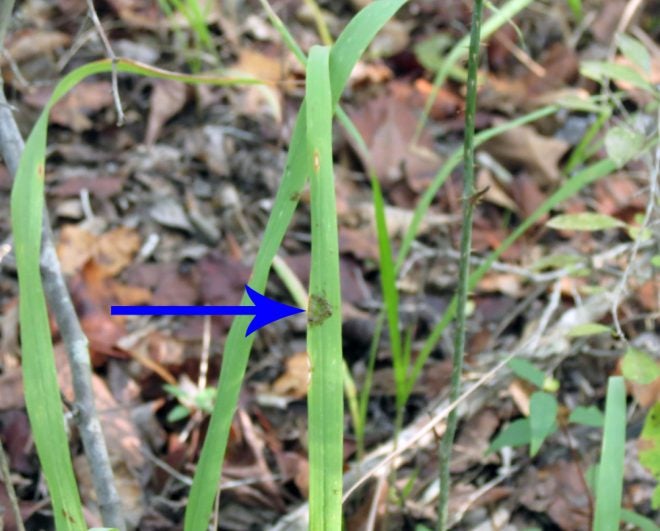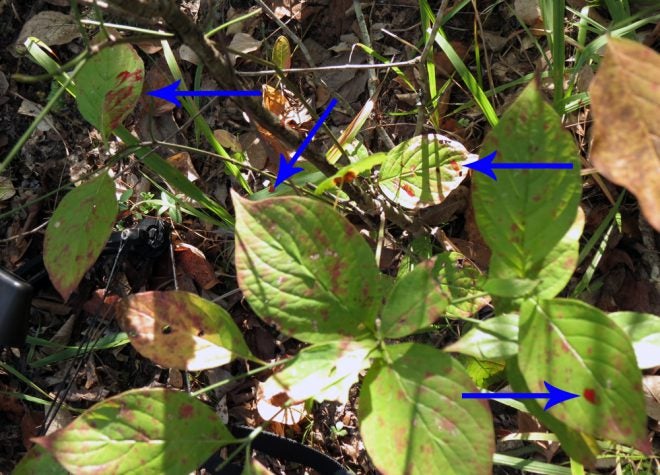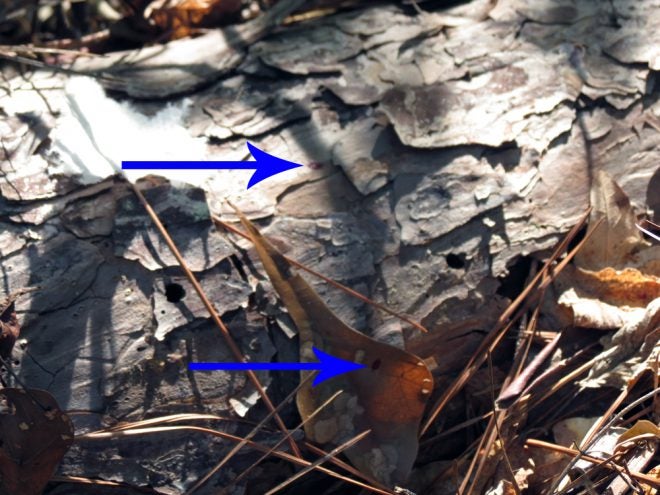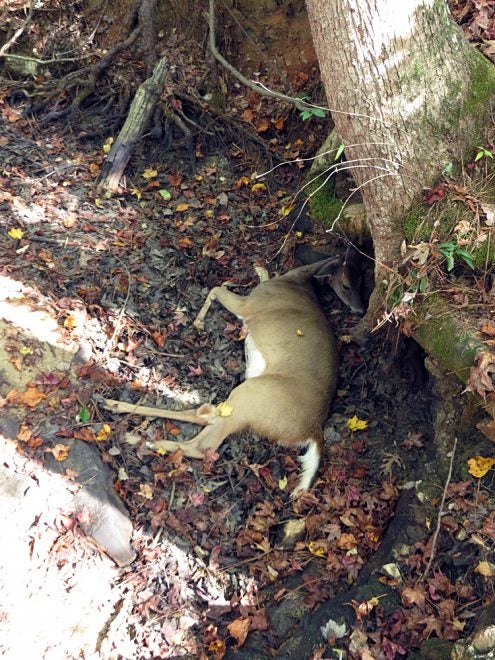The One That Almost Got Away
Russ Chastain 10.17.17

It’s been more than five years ago now, but in some ways it seems like only yesterday that I spent most of a day scouring the Georgia woods in search of a whitetail doe which I’d shot with a crossbow and finally found, using nothing less than pure mule-headed stubbornness combined with hands-and-knees blood trailing and a feel for which way the deer “should have” gone.
A cold front had finally shown itself in the Georgia woods, so I’d high-tailed it to camp to enjoy the coolness in hopes that the deer would begin to change their nocturnal summer ways. I headed to a tripod stand overlooking a small food plot. It was actually the same place I’d gotten my Made to Order Buck the previous year, but instead of a popup ground blind, I was perched up high.
After more than two hours in the stand, punctuated by the dropping of my quiver, a long (but missed) shot at a coyote, and retrieving my quiver, two deer stepped into the food plot. I needed a mature doe for my freezer, and the larger of these was definitely a candidate.
She was cautious and alert, staring up at the stand. I moved sloooowly and ranged her at 35 yards, then managed to get the crossbow into position by osmosis; shouldered it and scoped the deer. She faced me, but not quite head-on. I could see part of her left side, and aimed to my right of her chest. My intent was to drive the arrow just inboard of the left shoulder and on through the vitals, and the crossbow and broadhead were both capable of the job.
I never should have loosed that arrow; she was too alert and deer can move faster than arrows, or at least, fast enough to get out of the way of one. But at 9:13 I did take that shot.
At the release, the deer began turning to its left/my right, intent on getting out of there. Consequently, the arrow made contact near the rear of its right shoulder, drove through and ruined the rear of the right lung, and exited the center of the doe’s belly about a foot behind the ribs.
Of course, I didn’t know that. All I knew was that I had hit the deer somewhere towards the front end and that it had run away. The deer left the plot the way they’d come, and I heard crashing in the brush back there.
I tried to memorize the spot where she had left the food plot and busied my now-trembling hands by taking a compass bearing on the last crash I heard. I cocked the crossbow and gathered my gear, and slipped down out of the stand at 9:20. After some tedious work, I found a large tuft of hair where she had been at the time of the shot and tracked her to the edge of the woods, where I spotted another bunch of hair.
I hadn’t found any blood, but I got down on my hands and knees and crawled through the tiny opening in the thorny brush through which she had run. I hadn’t gone far when I found my arrow. The sign on it wasn’t comforting; some blood but plenty of gut juice as well. It was clear the arrow had passed completely through the deer.

Not far away, I spotted more of the brownish-gray liquid that indicated a gut shot. This was not good news.
I was moving painfully slowly on purpose, stopping to take photos with my camera (I had no smart phone at the time; imagine that) along the way. I didn’t want to jump the deer if it was lying somewhere bleeding out.

Then I found the blood in the photo above, an encouraging sign. The game trail had disappeared and I was now trailing through the woods. I slowly followed the blood trail, marking it with small bits of paper towel so I could backtrack as needed.
I prayed often, and the blood was not plentiful. At times I relied on scuffs in the leafy forest floor where there was no blood to guide me.
The trail led me generally downhill, which was a good sign; a gravely-wounded deer will tend to take the path of least resistance. The trail angled down the side of a hill, and as the minutes turned to hours, I walked to the bottom of the wooded hillside to gaze into the deeply-eroded seasonal creek at its base. I walked up and down that deep ditch, confident that my deer wouldn’t have been able to get out of there if it had gone in, but I turned up nothing.
Then the sparse blood trail took a discouraging turn… up the hill.

Cold Trail
After I found the blood in the photo above, I could find no more. I scoured the ground on hands and knees; nothing. So at 11:45, I started heading back to camp to resupply and to get a secret weapon in hopes of reviving the trail.
I later determined that the dead end was 168 yards from where the deer had been hit.
I didn’t linger at camp. I inhaled a peanut bar and a soda, loaded some gear on a borrowed ATV, and headed back to the woods at 12:31. I set my mind to keep searching until I found the deer or lost daylight.
My “secret weapon” was a small spray bottle of hydrogen peroxide. A friend had recommended it to help in blood-trailing, and this was my first opportunity to try it out. The idea was that it would make blood foam up so you could see it more easily.
I went back to the trail’s end and began looking ever-so-closely. Was that speck a bit of blood or just a spot on a leaf? A little spritz of hydrogen peroxide told the tale, because spots on leaves don’t foam, but blood or “gut juice” does.
There’s no way I could have confirmed that the pin-point spots I was finding were bodily fluid, if I hadn’t had the hydrogen peroxide.
One concern when trailing this way is that you’d better mark any spot that you confirm as blood, because it will foam away to nothing after contact. And you shouldn’t just hose down an area in hopes of spotting some foaming bits. Because if you happen to miss seeing any foamy bits, they will soon be gone forever.
The Last Dead End
After making another 80 yards’ progress, I hit another dead end at 2:00. There just wasn’t any more sign that I could find. The trail had finally led me down the hill and along a trail that abuts the deep ditch I mentioned eariler, and then it petered out.
My hope began to wane.
I marked the end of the trail, went and found the 4-wheeler and brought it to that spot. Drank some water to stay hydrated. Said a ten-thousandth prayer. Then went for a walk.
Now that I’d confirmed the wounded deer had walked along the deep wash, I walked on down the old trail while scanning the woods for a dead deer. After a long walk all the way down the creek bottom to the lake, I crossed the ditch and began working my way back up, scanning the woods on that side and looking down into the creek as well.
After a long, slow search, I rounded a bend at 2:53 and looked ahead into the wash, and spotted my deer lying there!

As you can imagine, the first thing I said was “Praise the Lord!” as I felt a great weight lift off of me at the sight. There are no words to express how good I felt to have finally found the animal I’d pursued for so long.
The deer lay 175 yards beyond the last bit of blood. It had been 5 hours, 40 minutes since I had fired the fateful arrow.
And now for the real work.
The ditch was deeper than I am tall, but I got my deer out of there and back to camp to shuck it out. I was all grins by then, but in my heart there was a sobering bit of darkness which I hope will color my hunting from now on.
In examining the wounds, I realized how close this had come to being a pure gut shot, and how much the deer had moved before the arrow had gotten there.
35 yards is simply way too far to sling an arrow at an alert deer, especially one that’s on full alert.
Some lessons from this hunt:
- I will not fling an arrow at a deer that’s on high alert.
- Don’t let deer “rules” get into your head. Things like “Hit deer never run with their flag up” or “critically wounded beer never go uphill” are generalizations and have many exceptions; don’t let campfire BS destroy your confidence.
- Consider moving ahead to scan the woods once you determine the general direction of the trail, rather than finding every speck of blood that’s there. If I had made a more-determined search of the ditch right away, I would have found my deer hours earlier.
- Always mark a blood trail. Wind or rain my ruin blood sign, but the bits of paper towel I dropped along the way allowed me to find the trail again whenever I lost my way or just needed to backtrack.
- Keep a sprayer of hydrogen peroxide handy; it can be a big help.
- Do what Winston Churchill advised: Never, never, never, never give up.
Have you ever had a similar experience? Feel free to share it in the comments below.